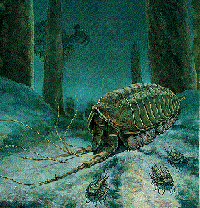

Guy Narbonne, a paleontolgist whose main work is in Ediacaran sites in the Northwest Territories, observed that Ediacaran fossils occured in Siberian platform rocks up to the level in which first worm teeth occured.
Predation like this, would select for animals which could rapidly evolve armour. In this theory, the rapid diversification of the Cambrian was a result of competition and predation. Marella's elaborate spiney carapace is a case in point.
Trilobites appear in great diversity very early in the Cambrian record. Possibly, a pre-existing, diverse soft-bodied trilobite assemblage evolved armour when predation selected for protected bodies.
Detail of painting by D.W. Miller from American Scientist, March-April, 1997.
 |
 |
 |